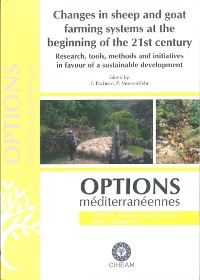| Article précédent | p. 319-323 | Article suivant |
Les systèmes ovins de production laitière dans le nord de la Tunisie
L'élevage ovin laitier en Tunisie a connu ces quinze dernières années un sérieux déclin, soit une diminution des effectifs de 90 pour cent et une productivité faible de 70 litres/brebis/lactation. Cet article vise l'analyse de ce type d'élevage dans les systèmes de production du nord de la Tunisie afin d'identifier les contraintes techniques et socio-économiques entravant ce secteur. Les résultats obtenus à partir d'une enquête exhaustive, sur l'élevage de la brebis Sicilo-Sarde, ont permis de recenser un effectif de 19 000 unités femelles dont 77 pour cent chez les privés. Une typologie des systèmes d'élevage en Analyse des Correspondances Multiples basée sur six variables liées à l'envergure de l'exploitation (taille de l'exploitation et effectif en unités femelles) et à la conduite des animaux (croisement, mode de sevrage et complémentation alimentaire) a permis d'identifier trois groupes d'éleveurs : (i) éleveurs de Sicilo-Sarde croisées ; (ii) éleveurs en évolution; et (iii) éleveurs de race pure. Le développement de ce secteur nécessite des politiques agricoles plus adaptées et un encadrement ciblé. La spécialisation en produits de terroirs pourrait assurer la durabilité de cette activité et dynamiser l'ensemble de la filière.
In Tunisia the dairy sheep sector has experienced, in these last fifteen years, a serious decrease. The reduction is about 90 percent of the total sheep number. This is associated to a low productivity estimated at an average of 70 liters/ewe/lactation. The aim of this paper is to analyze the dairy sheep production systems in order to identify the technical and socio-economic constraints influencing the sector. For this reason, an exhaustive investigation was carried out on the Sicilo-Sarde ewe breeding. This study allowed to count 19,000 females. The private sector holds 77 percent of the total ewe's number. A typology based on a Multiple Correspondence Analysis was carried out using six active variables related to the farm size, the ewe's number and the animals' production techniques (crossbreeding, mode of weaning and food complementation). This typology allowed identifying three groups of sheep farmers: (i) crossbreeders of the Sicilo-Sarde ewe; (ii) evolutioning breeders; and (iii) pure breed farmers. The development of this sector requires more adapted agricultural policies and a targeted monitoring. Specialization in terroir products could ensure the durability of this activity and make the chain more active.
- [ Afficher ]
- [ Télécharger ]
- [ Exporter la citation ]
Vous pouvez télécharger la citation au format :
- [ Imprimer ]
-
Mots-clés
ANIMAL LAITIER, CLASSIFICATION, OVIN, RACE (ANIMAL), SYSTEME D'ELEVAGE, SYSTEME D'EXPLOITATION AGRICOLE, TUNISIECiter cet article
Mohamed A., Khaldi R., Jaouad M., Rached Z., Khaldi G. Les systèmes ovins de production laitière dans le nord de la Tunisie. In : Pacheco F. (ed.), Morand-Fehr P. (ed.). Changes in sheep and goat farming systems at the beginning of the 21st century : research, tools, methods and initiatives in favour of a sustainable development . Zaragoza : CIHEAM / DRAP-Norte / FAO, 2009. p. 319-323. (Options Méditerranéennes : Série A. Séminaires Méditerranéens; n. 91). Proceedings of the Seminar of the Subnetwork on Production Systems of the FAO-CIHEAM Network for Research and Development in Sheep and Goats, 2007/11/15-17, Ponte de Lima (Portugal). http://om.ciheam.org/om/pdf/a91/00801165.pdf



